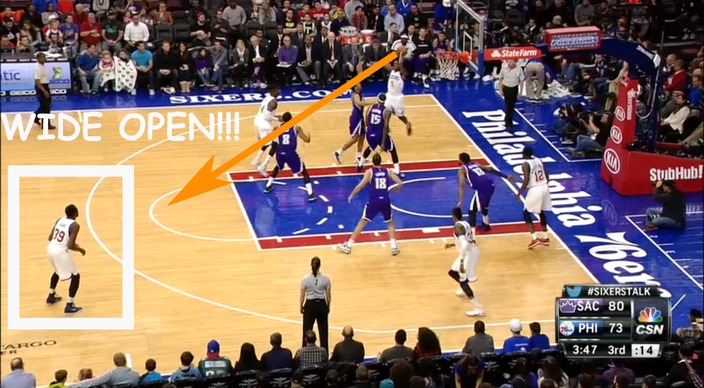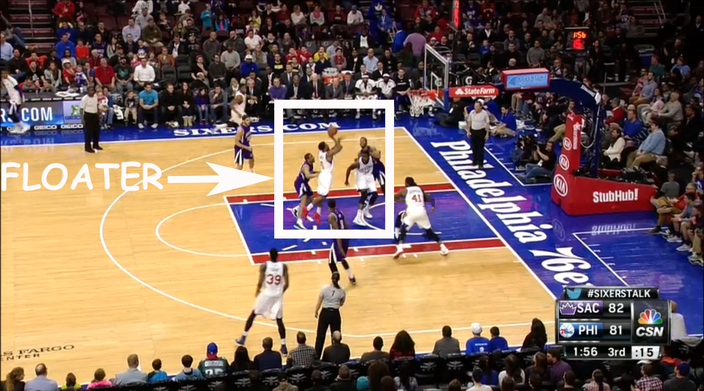
March 25, 2015
When Ish Smith checks into the game with 4:24 remaining in the third quarter, the Sixers are in need of a jolt, a sudden push that alters the game’s complexion. Up to this point on an early March Friday evening inside the Wells Fargo Center, the Sixers’ normally active frontline, led by a uniquely destructive defensive force in rookie Nerlens Noel, was at the mercy of DeMarcus Cousins’ powerful and punishing brilliance, and the Sacramento Kings held an 80-70 advantage because of it.
As Noel reflected after Cousins’ dominant 39-point, 24-rebound effort, "He's definitely a challenge, a big, big boy. I'll just go eat a couple of Big Macs and think about that."
Noel was liable to joke around after the rare outing in which he was dominated on defensive end of the floor (by a fellow Kentucky one-and-doner, to boot) because the Sixers ended up winning the game by a seven-point margin. On this night, the driving force behind the league’s most talked-about rebuilding project’s comeback happened to be an undersized 26-year-old point guard suiting up for his eighth NBA team in a five-year career, the type of out-of-nowhere contribution which has become par for the course on the 2014-15 Philadelphia 76ers. Smith finished the game with 10 points and nine assists, but the numbers understate his impact.
“Sometimes I don’t even know what I’ll be doing out there,” Smith said.. “I’ll just be going. And it looks good, and it’s the oohs and aahs and sometimes it looks terrible and y’all will be writing, ‘What the freak is he doing? It’s no wonder he’s been on 25 teams.’”
Whether you’re comfortable or not with the term “tanking,” the Sixers are constructed to lose a lot of basketball games in the short term. That much isn’t up for debate, even if Philadelphia and the subsection of the Internet known as Basketball Twitter wrangles with whether the strategy is both sound and moral on almost a daily basis. For the organization, the tricky balancing act is attempting to create a worthwhile environment where a roster littered with young, unheralded players can develop while also losing the requisite number of games to claim at least close to pole position at the May 19th draft lottery.
In the meantime, players like Smith — young cast-offs from other teams, second-round picks, and undrafted free agents — are tasked with building a culture that they most likely won’t have the opportunity to reap the benefits of. In return, the Sixers provide them with precious NBA playing time and the promise of a constructive environment dedicated to their individual improvement.
Players could be shipped out at a moment’s notice, mind you, but while here, the organization operates like the old Army slogan: Be all you can be. As general manager and puppet master Sam Hinkie honestly laid out the day after trading reigning Rookie of the Year Michael Carter-Williams, “Our promise is we’ll meet you every day, every day we’ll try to make you better, and every day we’ll try to lift you up, but that’s it. That’s the end of the agreement.”
Smith has largely taken advantage of his brief time in Philadelphia, specifically by taking his floor game to another level. In his first 16 games as a Sixer, the fifth-year guard assisted on 45.3 percent of his teammate’s baskets per NBA.com, which would lead the NBA over the likes of Russell Westbrook, Chris Paul, and John Wall if Smith played enough minutes to qualify. He has accomplished such a major jump in passing proficiency (his previous highest AST% for a season was 29.2, according to Basketball Reference) despite keeping the turnovers at his career average rate. Heady stuff, for sure.
It’s important to note that for Smith, such an accomplishment likely wouldn’t have been possible at any of the league’s 29 other outposts. Philly has essentially become a haven for down-on-their-luck players in search of extended minutes. One of head coach Brett Brown’s self-deprecating pet phrases during the infancy of “The Great Rebuild,” which is characterized by consistent player movement, is “shake a guy’s hand, and throw him in the game an hour later.” In Smith’s case, Brown shook his hand and tossed him the keys to the kingdom.
As a rule, fans generally tend to overvalue their own players. Of the Sixers currently on the floor, Noel is the only one who might be considered a building block moving forward, and even then, Hinkie would need to acquire at least two prolific offensive players to pair with the 20-year-old center whose shot-blocking prowess has earned him the nickname “The Eraser.” There might be some other keepers on the roster such as Jerami Grant or Robert Covington, but exceeding expectations on a likely 20-win team is totally different animal than earning a role on a title contender.
Smith certainly isn’t a miracle worker, mostly because he’s still an extremely inefficient scorer from pretty much everywhere on the floor (though to his credit, his shooting numbers are slightly better than his career averages on what for him is a ton of attempts). On the team level, he has made a slightly positive impact on the Sixers’ offense, but not anywhere near enough to considerably improve it from one of the last forty-plus years’ worst. Smith’s game still has plenty of warts attached, and he very well might not be in the Sixers’ plans past the last eleven games of the season. This is not a story about someone who turned himself into a building block.
Even so, Smith has made a major mark on the Sixers that is difficult to properly quantify. Is it possible to account for the excitement caused by him crossing Andre Miller out of his sneakers?
Or the strong on-court connection he has with Noel, who is making a bid for Rookie of the Year in part because his scoring average and shooting percentages have noticeably improved with Smith in the fold? (OK, you can place a number on that.)
Although Hinkie and the front office threw him a lifeline, Smith was placed in a difficult situation in having to steer such an undermanned offense. He responded by keeping the Sixers afloat and is carrying them to the finish line as a run-of-the-mill bad team, which is an accomplishment. Just as importantly, along with Noel he has been primarily responsible for managing to keep those fans still paying attention both entertained and interested, one lightning quick crossover at a time. For the mental health of his teammates and the beaten-down but resilient Sixers fan base alike, Smith was exactly what the doctor ordered: a shot of adrenaline.
“Sometimes I don’t even know what I’ll be doing out there,” Smith said of his creative ball-handling moves. “I’ll just be going. And it looks good, and it’s the oohs and aahs and sometimes it looks terrible and y’all will be writing, ‘What the freak is he doing? It’s no wonder he’s been on 25 teams.’”
Brown, the team’s relentlessly upbeat second-year coach, has become a fan favorite in Philadelphia for his ability to coax victories out of such an undermanned roster. A somewhat underrated tactician schooled in the art of X’s and O’s by basketball Jedi Master Gregg Popovich, the 54-year old spoke after the game against Sacramento in detail about the simple offensive strategy that earned his team a victory, while also giving credit to Smith’s execution.
“We tripped on the sideline tonight,” Brown said. “We played a lot out of a sideline pick-and-roll and got into it in different ways. [Smith] did a hell of a job of navigating floor spots, finding rollers for lobs and dunks, and playing that second side of the floor.”
There’s a scene early in “Remember the Titans” where Herman Boone (Denzel Washington) describes matter-of-factly why his playbook is so small. “It’s like Novocain, just give it time and it always works,” is the money line. More or less, that describes how the well-oiled Spurs machine runs under Popovich, and also how Brown likes to operate the Sixers. Eagles czar Chip Kelly famously was overheard emphasizing that “culture beats scheme” last year, but neither trump talent in the NBA, a completely star-driven league. While the front office patiently waits to acquire that caliber of player, Brown’s skinny playbook doesn’t supply any anesthesia. The Sixers’ offense is as far removed from the Knicks, who sport the league’s second-worst unit, as the Knicks are from the middle of the pack.
On the rare occasion something consistently works, Brown sticks with it until it doesn’t. Case in point: Against the Kings, the Sixers ran the same screen the screener (Covington screens Noel) into a side pick-and-roll (Noel screens for Smith) action on display directly below for five consecutive halfcourt possessions:
As a result, the Sixers came away with points on all five possessions. Brown primarily decided to keep going back to the well because Smith continued to create good shots out of that particular set, expertly reading the defense and taking whatever option it presented to him, whether it was a jump pass to the weak side or a floater in the lane:
As one might expect of a franchise that experienced more roster turnover than anyone else over the past two seasons, the contrast in measurables between the Sixers’ early-season point guard rotation and current one is striking. The 6-foot-6 Carter-Williams is playing his trade (not particularly well, it should be noted) for a likely playoff team in Milwaukee while 6-foot-5 Tony Wroten will spend the remainder of the season on the shelf after partially tearing his ACL.
Replacing them has been a couple of smallish guards in Smith and Isaiah Canaan, acquired at the trade deadline in exchange for rookie jumping jack K.J. McDaniels. Conventional wisdom held that such a size downgrade would place a major dent in the Sixers’ defense because it wouldn’t be physically possible to switch as liberally as they had become accustomed to.
Since the deadline, their 11th-ranked defense has actually improved with the two mighty mites and an elder statesman in Jason Richardson prominently involved in the backcourt. You can’t predict ball.
During that same game against Sacramento a couple of Fridays ago, Brown was rather livid at halftime, furious after his team surrendered a whopping 42 points in the second quarter to Cousins and Co. According to the almost all of the players and also the coach himself, the team received quite the tongue-lashing at halftime. Even though wins and losses aren’t of much consequence to Brown at this stage of the rebuild, the manner in which his team competes means absolutely everything.
“Coach was like, ‘That’s not the culture we’re trying to build here,’” Smith said. “He said, ‘Whether you’re playing for me now or later, whatever it is, that’s not how we’re going to do it. While you’re here, we’re going to play it this way.’ And I think we really, really responded to it.”
As was already mentioned at length, Smith sliced and diced the Kings defense in the second half, and that specific quote he offered after the victory is pretty telling of the dynamic inside the locker room. As fond as Brown is of his players, the coach fully understands that many aren’t long for Philadelphia, which Smith comprehends as well.
Moving forward, the Wake Forest product will attempt like heck to build on the 32 percent 3-point shooting he has been able to achieve in Philly (“Teams are going to go under [the screen], and force me to shoot,” he says) among every other aspect of his game. Whether Smith sticks around in Philly next year or is able to parlay his improved play into a backup role on another team, he undoubtedly has made solid use of his time here.
“He comes with a package of a big personality, big charisma,” Brown said.
Barring injury, he’ll continue to provide that jolt of energy until April 15th.

